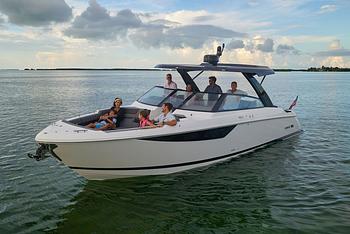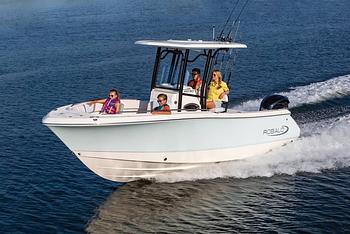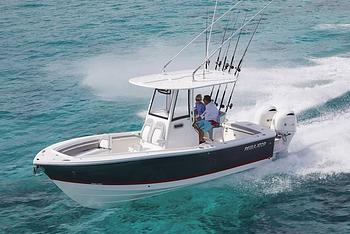Boat-stabilization technology has progressed by leaps and bounds in recent years. The first thing on this topic that comes to mind for most people is the advent of gyroscopic boat stabilizers such as the uber-popular Seakeeper, which is excellent for eliminating rock and roll. Another that you may have heard of are the newest fin-stabilizing systems, like Vector Fins, which can flap fast enough to stabilize the boat even at anchor. But neither of these systems address a different sort of motion: pitch and heave when underway at planing speed. Nor are they applicable to some small boats, which may not have the space nor the budget for such boat-stabilization systems. Today, however, we have what the newest player calls a “vessel attitude control” (VAC) system.
VACs have several component parts that all work together—sensors that detect motion in real time, a set of actuators that manipulate appendages on the stern of the boat, a user interface of sorts at the helm, and a computer brain that ties them all together. When a boat is traveling at planing speeds, the sensors detect pitch and roll and transmit the information to the computer brain in a tiny fraction of a second. The computer makes calculations, then tells the appendages how to move to counteract that pitch and roll.
The easiest way to visualize how a VAC system works is to think about a set of common trim tabs on the stern of your boat. But imagine those tabs were smart enough to feel when your boat was leaning over—even for a microsecond—and they were fast enough and strong enough to change position to counter the lean. Similarly, if the boat met a wave and the bow rose, they would be smart, fast, and strong enough to immediately counter the motion and keep your boat level even as it traveled from wave to trough to wave.
Of course, trim tabs are not nearly fast nor strong enough to accomplish these feats, and they’re only as smart as the captain operating the boat. That’s why the latest VAC systems look nothing like traditional trim tabs and come armed with sensors and brains. Even so, once you take a ride on a boat with a modern VAC system, you’ll have trouble believing what your own body and eyes tell you: these things can work some serious maritime magic.
Seakeeper Ride
The Seakeeper Ride VAC system, designed and built by the same company that brought us Seakeeper gyrostabilizers, was introduced barely over a year ago and is the latest and greatest to hit the water. At the heart of the system is a set of blades that mount on either side of a boat’s transom and are manipulated by rotary actuators that can move at blazing-fast speeds. Shockingly, they can make up to 100 adjustments per second. Even more shocking is that the inertial sensors used by Ride can take up to 1,000 measurements per second. Combine this sort of power with a computer, and that rough ride through the seas just became a whole lot smoother.
The system is designed for boats 35 feet or smaller, and depending on factors including hull design, boat size, weight, speed, and more, reduces motion by between 45 and 70 percent. Interestingly, different boats see different reductions in pitch versus roll; one may see a 60-percent pitch reduction and a 40-percent reduction in roll, while another may see 40-percent less pitch and 60-percent less roll.
We took a sea trial on a 30-foot center console, tried turning the system on and off over and over again, and while we didn’t have the equipment to take objective measurements, our subjective-o-meter told us that it felt like the overall motion while underway was reduced by right around 50 percent.

Can your boat automatically combat pitch, heave, and roll? It can with the Ride system installed. Seakeeper Ride photo.
Seakeeper Ride Installation
The Ride blades can be affixed to most, though not all, transoms of modern powerboats, and wedge plates can be used to accommodate for transom angles. Cables then need to be run to the software module, which is commonly located in the helm console. For the interface you can either integrate the system with your MFD (Ride is compatible with select Garmin, Simrad, and Raymarine units) or an optional keypad unit. There’s also a distribution module that has to be added between the blades and the brain.
While the Ride system can be DIY-installed by a competent boater, most people will have a certified dealer-installer do the work. This job does, after all, include drilling and screwing into the transom of your boat. Several boat manufacturers have also begun to offer factory installation as either standard or optional equipment on certain new model boats.

The Ride’s blades sit on either side of the boat’s transom. Seakeeper Ride photo.
Seakeeper Ride Cost
At the time of this publication, the smallest Ride system, the 450, for boats up to 26 feet in length, has an MSRP for $4,500. The 525 covers boats from 27’ to 30’ and lists at $7,500. And the Ride 600 for 31’ to 35’ boats is $10,500. Those numbers may not be small, but when considered as a percent of the boat’s overall value—or stacked up against the $16,500 to $24,100 cost for a gyroscopic boat stabilizer for similarly sized craft—the Seakeeper Ride cost will seem reasonable to most boaters.

The Ride can be displayed either via a separate display or on some select MFDs. Seakeeper Ride photo.
Zipwake
The Zipwake system predates Seakeeper Ride by several years, also predating the (trademarked) VAC label, and is called a “dynamic trim control system” by the manufacturer. The overall concept of the system is similar, although Zipwake utilizes interceptors. These are small blades that deploy vertically out of a housing mounted to the back of the transom. There’s a computer brain telling them what to do, and GPS, gyro, and accelerometer sensors that are constantly measuring motion.
The interceptors don’t move as quickly as Ride blades, but they’re five to 10 times faster than stock trim tabs. When we tested the system on a 31-foot sportfishing boat, we measured a 31-percent reduction in rocking and rolling on a digital inclinometer.
The Zipwake system has an interesting advantage in that it’s self-cleaning, as the blades automatically extend and retract every 24 to 48 hours to scrape themselves clean. Plus, multiple units can be lined up side by side to amplify their effect, thus handling boats all the way up to 100 feet in length.

Interceptors are housings with blades that slide down horizontally to grab the water and create lift. Zipwake photo.
Zipwake Installation
The self-contained Zipwake units are a relatively easy installation, and one boat builder we spoke with has even stated that they’re easier to install than regular trim tabs. Along with the interceptor blades either a small controller must be mounted at the helm, or an integration module that interfaces with any NMEA2000 MFD display can be mounted behind the helm. An additional controller panel with a graphic display can also be mounted at the helm, if desired.
Zipwake systems can be mounted either with the cables going through the transom directly behind the interceptors (below the waterline) or with cables traveling up the transom to avoid drilling through it. DIY installation is considered a reasonable option, but the average powerboater will still leave it to the professionals.
Zipwake Cost
Zipwake systems are sold by individual distributors, so cost may vary. That said, fully inclusive Zipwake Series S systems (for boats up to 50’) can be found advertised for between $2,800 and $4,500. Series E systems for boats 50’ to 100’ start at around $8,500, but generally require professional assistance for both the system-design requirements and installation.

With an integration module, the Zipwake interface can be displayed on any NMEA2000 compliant MFD. Zipwake photo.
Whether one of these new forms of boat stabilizers is right for you and your needs is an open question. And in many cases the application of a gyroscopic stabilization system may be more appealing—we’ve even heard of people getting both, to maximize the best of both worlds in boat stabilization whether the boat is moving or at rest. Either way, one thing is for sure: if you’re sick and tired of all that pitching, heaving, and rolling, you can finally do something about it.



